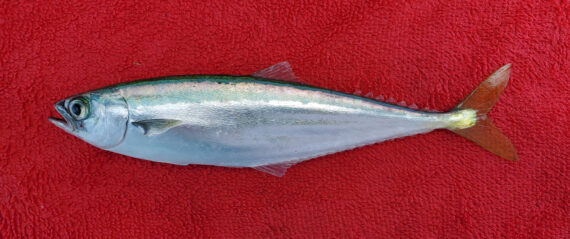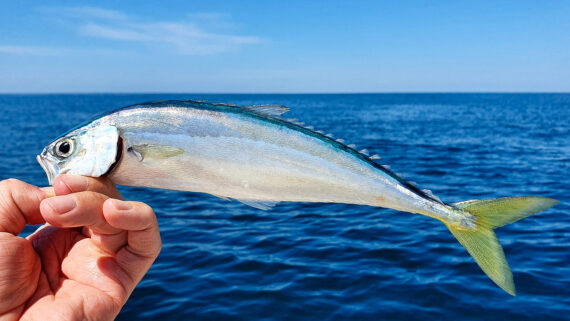Shortjaw Leatherjack, Oligoplites refulgens
 Shortjaw Leatherjack, Oligoplites refulgens. Fish provided by the commercial bait salesmen of Jaco, Costa Rica, December 2020. Length: 15 cm (5.9 inches). Photograph courtesy of Chris Wheaton, Fullerton, California.
Shortjaw Leatherjack, Oligoplites refulgens. Fish provided by the commercial bait salesmen of Jaco, Costa Rica, December 2020. Length: 15 cm (5.9 inches). Photograph courtesy of Chris Wheaton, Fullerton, California.
 Shortjaw Leatherjack, Oligopiltes refulgens. Fish provided by the commercial fishermen of Bahía Kino, Sonora, March 2015. Length: 18 cm (7.1 inches). Photograph and identification courtesy of Maria Johnson, Prescott College Kino Bay Center, Kino Bay, Sonora.
Shortjaw Leatherjack, Oligopiltes refulgens. Fish provided by the commercial fishermen of Bahía Kino, Sonora, March 2015. Length: 18 cm (7.1 inches). Photograph and identification courtesy of Maria Johnson, Prescott College Kino Bay Center, Kino Bay, Sonora.
 Shortjaw Leatherjack, Oligoplites refulgens. Fish caught from coastal waters off Mazatlán, Sinaloa, October 2021. Length: 28 cm (11 inches). Catch, photograph and identification courtesy of Bart, The Netherlands (worldangler.eu).
Shortjaw Leatherjack, Oligoplites refulgens. Fish caught from coastal waters off Mazatlán, Sinaloa, October 2021. Length: 28 cm (11 inches). Catch, photograph and identification courtesy of Bart, The Netherlands (worldangler.eu).
The Shortjaw Leatherjack, Oligoplites refulgens, is a member of the Jack or Carangidae Family, and is known in Mexico as piña flaca. There are six global members of the genus Oligoplites, of which four are found in Mexican waters, one in the Atlantic and three in the Pacific Ocean.
The Shortjaw Leatherjacks has a very compressed elongated body with a depth that is 19% to 23% of standard length. They are silvery in color with yellow tinges around their throat, dark anal and dorsal fins, and yellow caudal and pectoral fins. Their head has a pointed snout and a small mouth that ends before the rear margin of the eyes and has two distinct rows of teeth. Their anal fin has 2 standalone spines followed by 1 spine and 19 to 22 rays and is followed by 11 to 15 semi-detached finlets and is equal in length to the second dorsal fin; their caudal fin is deeply forked with a slender base; their dorsal fin has 4 or 5 standalone spines followed by 1 spine and 19 to 21 rays and is followed by 11 to 15 semi-detached finlets; and, their pectoral fins are short. They have 6 to 8 gill rakers on their upper arch and 19 to 22 on their lower arch. Their body is covered with needle-shaped scales and has no scutes. Their lateral line is arched over the pectoral fins but generally straight.
The Shortjaw Leatherjacks are a pelagic schooling species found inshore and in estuaries over sandy bottoms at depths up to 30 m (100 feet). They reach a maximum of 30 cm (12 inches) in length. The Shortjaw Leatherjack is poorly studied with very limited information available about their lifestyle and behavioral patterns including specific details on age, growth, longevity, movement patterns, diet, habitat use, and reproduction.
The Shortjaw Leatherjack is a resident of all Mexican waters of the Pacific Ocean with the exception that they are absent from south of La Paz, Baja California Sur, on the east coast of Baja and along the entire west coast of Baja.
The Shortjaw Leatherjack can be easily confused with the Longjaw Leatherjack, Oligoplites altus (deeper body; mouth extending well behind the eyes) and the Leatherjack, Oligoplites saurus (long jaw; clear anal and dorsal fins; yellow caudal fin).
From a conservation perspective the Shortjaw Leatherjack is currently considered to be of Least Concern with stable, widely distributed populations. They are pursued by commercial fishermen at a modest level and caught with nets but are considered to be a marginal food fish. They are also a target of recreational fishermen being an excellent foe on light tackle and provide a strong fight with jumping. Their dorsal and anal spines are reported to be venomous, and should be avoided.